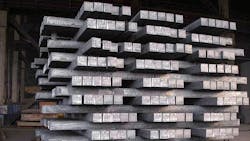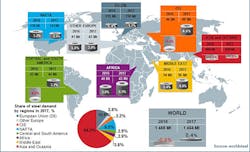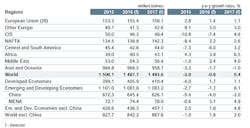A new short-range forecast of global steel demand anticipates a continuing decline through the remainder of 2016 before a slight recovery takes hold in 2017. The forecast is a semi-annual report by the World Steel Association, the trade group that includes steelmaking enterprises in 66 nations, about represents 85% of the total global steelmaking capacity.
Global steel consumption rates have been declining for more than two years, and production volumes have been falling in response. Even so, the market is presently operating at below the installed capacity, weakening prices and contributing to future forecasts for lower demand
The latest forecast indicates that global steel demand will decline by 0.8% this year to an estimated 1.488 billion metric tons, following the 3.0% annual decline shown in the 2015 global steel production (1.62 billion metric tons.)
Looking further, the new forecast sees global steel demand growing by 0.4% in 2017, to a total of 1.49 billion metric tons.
“The economic environment facing the steel industry continues to be challenging,” according to T.V. Narendran, chairman of the World Steel Economics Committee, “with China’s slowdown impacting globally across a range of indicators contributing to volatility in financial markets, sluggish growth in global trade, and low oil and other commodity prices.
“The global steel market is suffering from insufficient investment expenditure and continued weakness in the manufacturing sector,” continued Narendran, who is also the managing director of India’s Tata Steel. “In 2016, while we are forecasting another year of contraction in steel demand in China, slow but steady growth in some other key regions, including NAFTA and EU, is expected. Growth for steel demand in all markets except China is expected in 2017.”
Because China is the source of about half of all the raw steel produced worldwide, the ongoing industrial recession in that country is complicating the outlook for global demand recovery. In addition, the Chinese industry is working to comply with regulatory programs that seek to consolidate capacity and eliminate out-of-date operations.
World Steel pointed to a number of specific problems for steel demand in relation to the Chinese economy. Specifically, the Chinese economy continues to decelerate, and a depression in construction activity is contributing to a decline in manufacturing overall, especially for metal products, as well as to slower growth in automotive production.
Moreover, there is no forecast for a recovery for the Chinese construction sector, and the decline in steel demand in China is expected to be -4.0% in 2016, followed by -3.0% in 2017. This suggests a demand of 626.1 million metric tons steel (15% down from 2013) for 2017, a contraction to 41.9% of world steel use from 47.9% in 2009 and 44.8% in 2015.
Growth Indicators Beyond China
World Steel also pointed to several more threats to global demand recovery, including corporate debt, anxiety in the financial markets, high household debt and volatile capital flows in many emerging economies, and unstable political situations in several regions, which could undermine global economic conditions.
More encouragingly, World Steel noted that emerging economies in South and Southeast Asia are exhibiting resilience, and together with improvements in NAFTA and the EU support the forecast for recovery in 2017.
“We expect that steel demand outside China will continue to grow by 1.8% in 2016 and this growth will accelerate to 3.0 % in 2017,” according to Narendran.
Outside China, the forecast sees declining investment in oil-and-gas drilling and processing affecting steel demand, though lower oil prices have eased inflation for oil-importing countries. In any case, the forecast concludes that the global commodity markets are “at or near the bottom of this cycle.”
The forecasters also see evidence of the Chinese economic problem slowing manufacturing exports in emerging economies, especially Asian markets. “The same is true for developed countries experiencing a reduction in the exports of consumer goods and machinery,” their statement added.
Specifically, the markets for mechanical machinery, metal goods, and non-automotive transport sectors are weakening, though the automotive sector will continue growing on strong demand in many countries.
Outside China, construction should maintain a mild, but steady recovery - particularly in India and MENA and ASEAN regions.
Regional market conditions offer additional economic dimensions to the forecast in emerging markets. For example, Russia and Brazil have internal political and structural issues that are inhibiting new investment. In Turkey, pro-growth policies by the government are expected to prompt steady (3.3% in 2016, 3.2% demand in 2017) steel demand. Five ASEAN nations (Thailand, Malaysia, Vietnam, Indonesia, Philippines) are exposed to Chinese market weaknesses, but steel demand is expected to grow by 6% due to infrastructure building activity.
In developed economies, worsening global economic conditions will not alter a recovery in steel demand. Steel demand in the developed economies is seen growing 1.7% in 2016 and 1.1% in 2017. In the EU, a mild recovery in steel demand is underway, with economic confidence and investment activity generally improving. There is some reason for concern in regard to the ongoing economic impact of the refugee situation in some countries of Europe, and the ‘Brexit’ issue may have adverse effects on future trade and investment. The forecast for steel demand in the EU is for 1.4% growth in 2016, and a further 1.7% in 2017.
In the U.S., steel demand has been reduced by falling oil prices and a strong dollar, but the forecast sees improving job market and a strong housing sector countering those effects. The forecast for steel demand in the U.S. is for 3.2% growth in 2016 and 2.7% growth in 2017.
About the Author
Robert Brooks
Content Director
Robert Brooks has been a business-to-business reporter, writer, editor, and columnist for more than 20 years, specializing in the primary metal and basic manufacturing industries.



